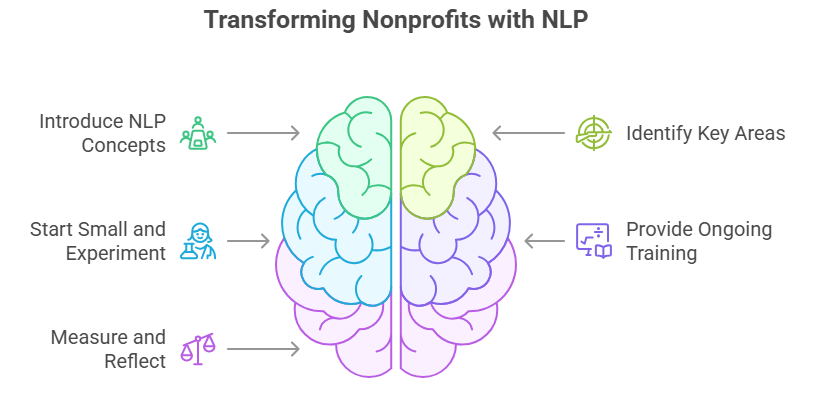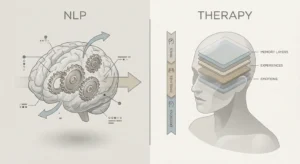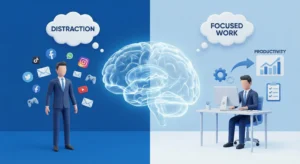In Toronto’s nonprofit sector, success isn’t just about hard work; it’s about effective communication, strong leadership and building meaningful connections. That’s where NLP (Neuro-Linguistic Programming) can make a real difference. NLP isn’t about manipulating language; it’s about understanding human behavior and using that insight to improve team dynamics, engage donors, and enhance organizational effectiveness.
Whether you want to motivate your team, strengthen relationships with supporters or improve your leadership skills, NLP offers simple yet powerful tools to drive lasting success. Let’s dive into how this transformative tool can elevate your nonprofit and help you make a bigger impact.
NLP in Toronto Nonprofits: What It Means and How It Works
NLP, or Neuro-Linguistic Programming, is a tool that helps nonprofits enhance communication, improve leadership and strengthen team dynamics. At its core, NLP focuses on understanding how people think, speak and behave, and then using that insight to create better outcomes.
For nonprofits in Toronto, NLP offers practical strategies to improve interactions within teams and with donors. It’s not just about the words people use but understanding the deeper meaning behind them. By applying NLP, nonprofits can build stronger connections, resolve conflicts more efficiently and boost organizational motivation.
The power of NLP lies in its simplicity. It provides actionable techniques to improve everyday communication, increase empathy and foster collaboration. For nonprofits, this means creating an environment where everyone is aligned and working toward a common goal. Simply put, NLP helps nonprofits operate more effectively and sustainably, setting them up for long-term success.
How NLP Enhances Leadership in Toronto Nonprofits

Leadership in nonprofits isn’t just about managing people; it’s about connecting, understanding and guiding your team to reach shared goals. NLP can help nonprofit leaders become more aware of their behaviors, improve communication and lead more effectively.
Understanding Leadership Through NLP
NLP helps leaders understand their thought patterns, reactions and communication styles. Leaders can adapt their approach to better connect with their team by becoming more self-aware. Imagine a leader who understands how their words and actions influence others this awareness can lead to stronger, more trust-filled relationships.
Building Emotional Intelligence with NLP
Effective leadership requires emotional intelligence, and NLP is a powerful tool for building it. By practicing techniques that help leaders recognize and manage their own emotions, they can navigate tough situations with more calm and clarity. This emotional regulation allows leaders to make better decisions, reduce stress and create a positive, supportive environment for their teams.
Using NLP for Effective Communication
Good communication is at the heart of great leadership. NLP teaches leaders how to communicate more clearly and empathetically. Whether it’s through active listening, reframing a difficult conversation or building rapport with team members, NLP helps leaders create an environment where everyone feels heard and understood. With these skills, leaders can guide their teams more effectively, encourage collaboration and boost morale.
By applying NLP techniques, nonprofit leaders in Toronto can unlock a new level of leadership, ensuring they build stronger teams, engage with confidence,and lead their organizations to greater success.
How to Build Stronger Teams with NLP in Toronto Nonprofits
Building a strong, cohesive team is vital for any nonprofit to succeed. Each member plays a key role in achieving the mission, so creating an environment where everyone works well together is essential. NLP can help you strengthen your team by improving communication, trust and collaboration.
Improving Team Dynamics with NLP
Effective teams are built on mutual respect and understanding. NLP allows team members to understand each other’s perspectives better. With techniques like active listening and rapport building, team members can connect more deeply and work better together. Think of it like tuning a musical instrument each team member needs to be in harmony with the others to create a smooth, effective working environment.
Managing Conflict Within Nonprofit Teams
Conflict is inevitable in any team, but how it’s managed makes all the difference. NLP provides tools to resolve conflicts constructively and calmly. By using reframing techniques or helping individuals understand the emotions behind their actions, you can turn a disagreement into a learning experience. Instead of letting conflict divide your team, NLP helps channel it into better communication and stronger collaboration.
Motivation and Team Engagement with NLP
A motivated team is a productive team. NLP helps leaders tap into their team members’ intrinsic motivators, allowing them to align individual goals with the nonprofit’s mission. Whether through understanding personal values or using positive reinforcement techniques, NLP fosters an environment where people feel empowered and driven to contribute their best.
With NLP, nonprofit teams in Toronto can become more than just a group of people working together; they can become a unified, motivated force focused on achieving the mission and making a real impact.
How NLP Can Strengthen Fundraising and Donor Relationships
Fundraising is all about connection. The more you connect with your donors personally, the more likely they are to support your mission. NLP offers practical strategies to build strong, lasting relationships with donors, helping you communicate more effectively, understand their needs and engage them meaningfully.
Building Rapport with Donors Using NLP
Rapport is the foundation of any strong relationship and NLP provides tools to build it quickly and effectively. Key techniques include:
- Matching body language: Subtly mirror the donor’s body language to create a sense of comfort and trust.
- Mirroring speech patterns: Match your donor’s tone, pace and language style to establish a connection.
- Active listening: Show you genuinely understand and care about the donor’s values and concerns.
By using these techniques, you form a connection that goes beyond the surface, making the donor feel valued and understood.
Persuasive Communication in Fundraising
Effective fundraising isn’t just about asking for money; it’s about telling a compelling story. NLP helps you:
- Reframe the conversation: Present your cause in a way that aligns with the donor’s values.
- Use powerful language patterns: Speak in ways that inspire action and emotion.
- Highlight shared goals: Connect your mission to something the donor cares deeply about.
These strategies allow you to motivate donors, making them feel personally connected to the cause and more likely to contribute.
Strengthening Donor Trust and Loyalty with NLP
Trust is the cornerstone of donor relationships. NLP can help you:
- Understand donor thought patterns: Learn what resonates with them, making your communication more effective.
- Align messaging with donor values: Ensure your communication reflects what donors care about.
- Be transparent: Consistently demonstrate how donations make an impact.
This builds long-term trust, turning one-time donors into loyal supporters who believe in the mission.
By using NLP in your fundraising strategy, Toronto nonprofits can create deeper connections with their donors, improving communication and increasing the likelihood of sustained support.
Practical Steps for Implementing NLP in Your Toronto Nonprofit
Implementing NLP in your nonprofit can transform your organization’s communication, leadership and overall effectiveness. Here’s a simple step-by-step guide to get started.

Introduce NLP Concepts to Your Team
Start by familiarizing your team with the basics of NLP. Hold a training session or workshop where you explain NLP’s core principles and share examples of how NLP can improve communication, teamwork and leadership.
Make it relatable by showing real-world examples of how NLP can help with conflict resolution or strengthen donor relationships.
Identify Key Areas for NLP Application
Next, determine where NLP can make the most significant impact in your nonprofit. Focus on areas like:
- Team communication: Improve how your team collaborates and understands each other.
- Leadership: Equip your leaders with tools to motivate and guide their teams more effectively.
- Donor relations: Use NLP techniques to build stronger, more meaningful relationships with donors.
Understanding where to apply NLP will help you prioritize and focus efforts on the most impactful areas.
Start Small and Experiment
Rather than trying to implement NLP across the board all at once, start small. Choose one area, like team communication or leadership and experiment with basic NLP techniques.
- For instance, try using rapport-building techniques in your next meeting or practice reframing during difficult conversations.
- See what works and adjust based on feedback.
Taking a small step allows you to fine-tune your approach without feeling overwhelmed.
Provide Ongoing Training and Support
NLP isn’t something you learn overnight. To make it stick, provide ongoing training and support. Consider:
- Regular workshops or coaching sessions for team members to practice and refine their skills.
- Encouraging team members to share experiences and learn from each other.
The more you practice NLP, the more natural it will become for your team, making it a valuable tool over time.
Measure and Reflect on Your Progress
Finally, measure the impact of NLP on your nonprofit’s performance. Look for changes in:
- Team dynamics: Are meetings more productive? Is communication clearer?
- Leadership effectiveness: Are leaders engaging their teams better?
- Donor engagement: Are donor relationships stronger and more meaningful?
Regularly reflect on these areas and adjust your approach as needed to continue improving.
By following these five steps, your Toronto nonprofit can start integrating NLP into its operations. This will lead to better communication, stronger leadership and more engaged donors. Keep it simple, stay consistent, and watch your organization thrive.
Conclusion
NLP holds immense potential to elevate your nonprofit’s communication, leadership, and donor engagement. By adopting NLP techniques like rapport-building, effective reframing, and improved emotional intelligence, you can create a more collaborative, motivated team and foster deeper connections with donors. With these tools, your nonprofit can function more efficiently, boost productivity, and work toward achieving your mission with greater impact. Integrating NLP consistently into your daily operations will unlock long-term success for your organization. Ready to take your nonprofit to the next level with NLP?
FAQs for NLP in Toronto Nonprofits
What is the cost of NLP training for Toronto nonprofits?
NLP training for Toronto nonprofits usually costs between $500 and $5,000, depending on the provider, format, and duration. Workshops, group coaching, and one-on-one sessions may vary in price. Many training companies also offer nonprofit discounts to make programs more accessible..
What are the benefits of using NLP for Toronto nonprofits?
NLP helps Toronto nonprofits by improving communication, leadership effectiveness, and donor relationships. It reduces team conflicts, strengthens collaboration, and builds donor trust. By aligning staff and supporters, NLP creates sustainable growth and increases fundraising success across nonprofit organizations.
Why should Toronto nonprofits invest in NLP for fundraising?
Toronto nonprofits should invest in NLP for fundraising because it builds rapport with donors, enhances persuasive communication, and aligns messaging with donor values. This fosters trust and loyalty, turning one-time supporters into long-term donors, which significantly boosts fundraising outcomes.
How can nonprofits in Toronto implement NLP effectively?
Nonprofits in Toronto can implement NLP by starting with workshops or training, applying techniques in leadership and donor relations, and practicing methods like reframing and rapport-building. Small pilot projects, ongoing coaching, and progress tracking help ensure NLP creates long-term impact in the organization.
How does NLP compare to other leadership tools for nonprofits?
NLP differs from traditional leadership tools because it focuses on thought patterns, emotional intelligence, and communication styles. Instead of rigid frameworks, NLP offers flexible, practical techniques that adapt to different nonprofit environments, making it a powerful option for team building and donor engagement.
Is NLP safe for nonprofit teams to use in Toronto?
Yes, NLP is safe for nonprofit teams when used ethically and with proper training. It emphasizes understanding human behavior and improving communication, not manipulation. By applying NLP respectfully, organizations build trust, strengthen collaboration, and enhance staff and donor relationships.





